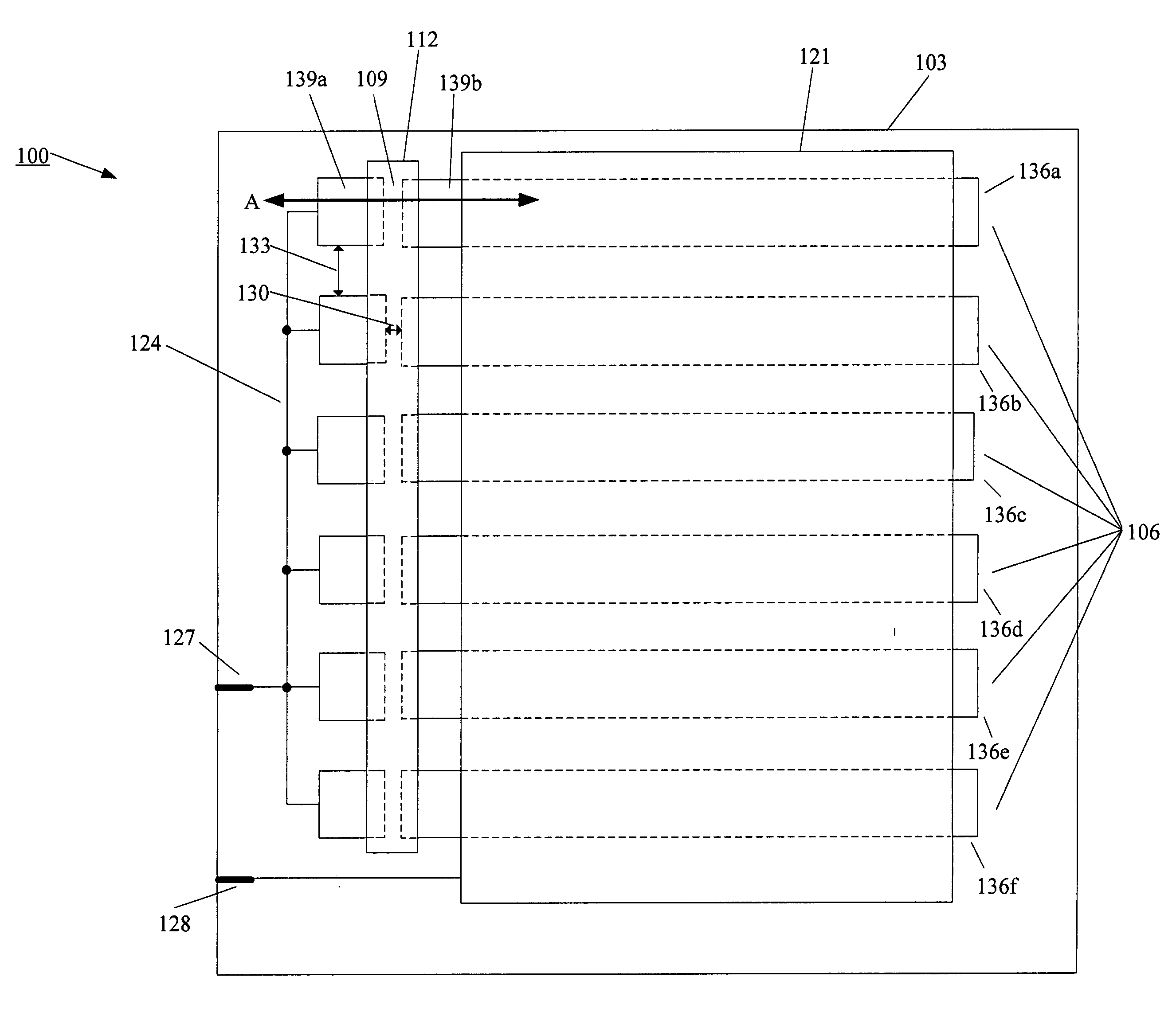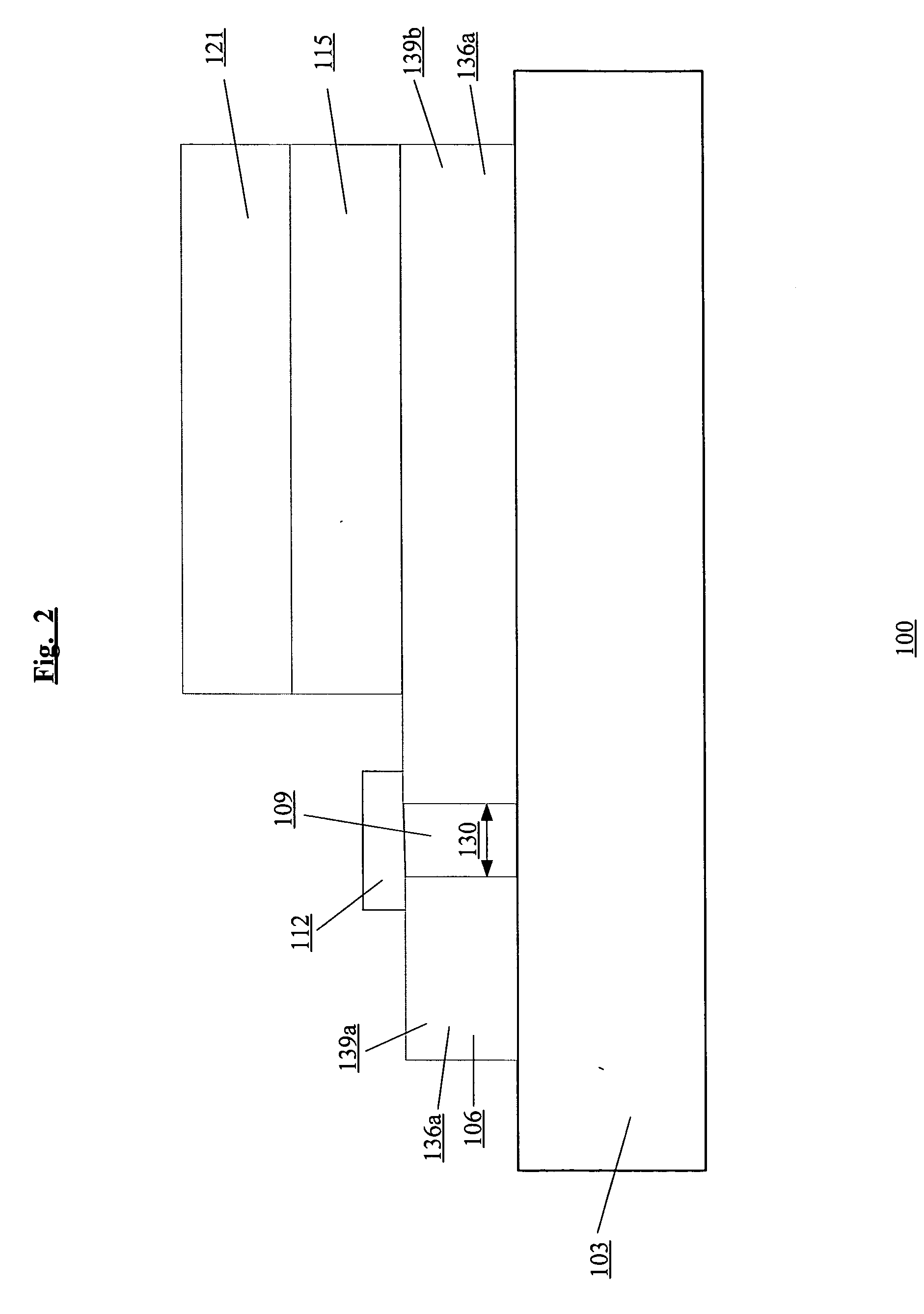Integrated fuses for OLED lighting device
a technology of integrated fuses and lighting devices, which is applied in the direction of discharge tubes/lamp details, organic semiconductor devices, discharge tubes luminescnet screens, etc., can solve the problems of cumbersome manufacturing of lighting devices with external contacts for each strip, increased complexity of driver circuitry, and increased complexity of connection components, so as to reduce current flow across the fuse material and increase the resistivity of the fuse material
- Summary
- Abstract
- Description
- Claims
- Application Information
AI Technical Summary
Benefits of technology
Problems solved by technology
Method used
Image
Examples
first embodiment
[0041]FIG. 2 shows a cross-section at line A of the OLED lighting device 100 according to the present invention. In FIG. 2, the first electrode 106 is on the substrate 103. The first electrode 106 is patterned into multiple strips and a particular one of these strips include one or more gaps that are on the substrate and located outside the active area of the lighting device. The one or more gaps in a strip segment the strip into two or more strip segments. Specifically, in FIG. 2, the strip 136a includes a gap 109 that segments the strip 136a into a first strip segment 139a and a second strip segment 139b. A fuse material 112 is nonselectively deposited on the first electrode 106 such that it covers the gap 109 and electrically connects the first strip segment 139a and the second strip segment 139b. When the fuse material 112 is nonselectively deposited, then the gap width 130 should be substantially smaller than the distance between adjacent strips so that cross-talk between the a...
second embodiment
[0042]FIG. 3 shows an OLED lighting device 100 according to the present invention. In this embodiment, a first electrode 106 is on a substrate 103. The first electrode 106 is segmented into multiple strips 136a-f and each of the strips 136a-f has a gap (e.g., strip 136a has a gap 109) that segments the strip into a first segment and a second segment (e.g., the gap 109 segments the strip 136a into a first strip segment 139a and a second strip segment 139b). The gap 109 prevents the flow of electric current between the first strip segment 139a and the second strip segment 139b. In this embodiment, the fuse material 112 is selectively deposited on the gaps so as to cover the gaps and provide an electrical connection between the first strip segments and the corresponding second strip segments. Specifically, in FIG. 3, the fuse material 112 is deposited on the gap 109 so as to provide an electrical connection between the first strip segment 139a and the second strip segment 139b. In this...
third embodiment
[0044]FIG. 5 shows the OLED lighting device 100 according to the present invention. In this embodiment, the first electrode 106 is on the substrate 103. The first electrode 106 is patterned into multiple strips 136a-f and each of the strips 136a-f has a gap (e.g., strip 136a has a gap 109) that segments the particular strip into the first segment and a second segment (e.g., the gap 109 segments the strip 136a into a first strip segment 139a and a second strip segment 139b). The gap 109 prevents the flow of electric current between the first strip segment 139a and the second strip segment 139b. The bank structure 142 is formed on the first electrode 106 and includes the multiple apertures 145a-f. The apertures expose the gaps between the strip segments. For example, the aperture 145a in bank structure 142 exposes the gap 109 between the first strip segment 139a and the second strip segment 139b. The apertures can represent pockets or lines. In this embodiment, the fuse material 112 i...
PUM
 Login to View More
Login to View More Abstract
Description
Claims
Application Information
 Login to View More
Login to View More - R&D
- Intellectual Property
- Life Sciences
- Materials
- Tech Scout
- Unparalleled Data Quality
- Higher Quality Content
- 60% Fewer Hallucinations
Browse by: Latest US Patents, China's latest patents, Technical Efficacy Thesaurus, Application Domain, Technology Topic, Popular Technical Reports.
© 2025 PatSnap. All rights reserved.Legal|Privacy policy|Modern Slavery Act Transparency Statement|Sitemap|About US| Contact US: help@patsnap.com



